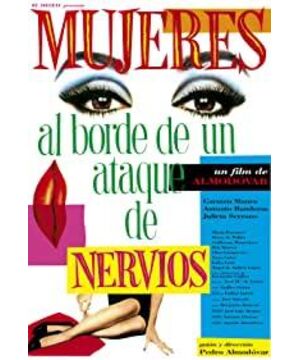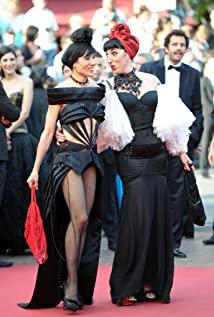Women On The Verge of Nervous Breakdown introduces a drama about female roles in chaos. The director Almodóvar utilized intertextuality to borrow elements from other works. By representing the film like screwball comedy and melodrama, Women on the Verge portrays three different kinds of women and they could be contextualized to explain the social circumstance of Spain in 1980s.
Three female images and their corresponding national identities
1 Lucia
Lucia is the wife of the male protagonist Ivan, who left Lucia many years ago. Since then, Lucia becomes psycho. Her image gives the viewer a feeling of retro and collaging. Her exaggerated wig and vintage suit make her like a woman from 1970s or even before. Lucia appears to be mentally unbalanced but become sober at some point.
This profile shot shows her head in the wind, funny and eye-capturing. Lucia is on the way to airport and plan to kill Ivan. By using this profile shot of her head, it shows Lucia's impenetrability (Acevedo-Muñoz, 2006). Her mental disorder belies her revenge.
The role of Lucia could be a metaphor of those people who is entangled with past and could not get rid of the influence of history cultural legacy. After the regime in 1975, many cultural practices were repressed in the transitional period. People with old cultural revenge , however, were also trapped by the limitation of past, like Lucia realizes she should be in hospital like she used to.
2 Candela
Candela is the female protagonist Pepa's friend. She is open to love but become desperate and maniac when she knows that she may in trouble of living with terrorists. At the same time, Candela is still dare to earn herself love by flirting with Ivan's son Carlos .
Candela represents the people who is willing to touch upon new objects in the cultural transition. There were “cultural anxiety” and “generic instability” in Spanish culture at 1980s. Although there are political and sexual liberation with artistic freedom in this kind of “new Spanish mentality", they could also be coward and scared when new trends sweep.
3 Pepa
Pepa is the female protagonist and she is in search of her lover Ivan to tell him that she got pregnant. She spends time on the phone listening or asking others about Ivan. However, she does not get the chance to meet Ivan in person. At last, Pepa moves Ivan from her emotion and to save him not from love and this turn her from a loser to a winner (Willem, 1998). The growing of Pepa could be related to the Hitchcock. In Hitchcock's film there are male roles who are being psycho, here Almodóvar reversely use it to express that women could also liberate themselves from neurotic men (Acevedo-Muñoz, 2006).
Pepa represents the people who are searching in the background of a chaos world and get rid of the negative side of the last. Ivan could be a metaphor of the history that haunted people. Eventually, Pepa leave Ivan decisively and broke the repressive chain with Ivan . Ivan represents the dictatorial political relationship of under General Francisco Franco's regime in 1975. Pepa's leaving is the metaphor that the Spanish society have escape from dictatorial repression (Hodge, 2010). At the end of the film, Pepa and Merisa are talking on the peaceful terrace, when Merisa says that she has had a good dream. This reveals the optimism of Almodóvar. Although Spain has gone through cultural transition or other chaos just like Pepa, it will reborn with other new culture and more democratic social order.
Women and power relationship
In the film, Pepa searches for every chance to hear Ivan's voice. However, Ivan could leave his voice and leave without responsibility. Here it could be understanded as that men have the right to let women waiting and do not care the feeling of women. Women and men could not talk to each other with respect and equality. The patriarchy in the legacy of dictatorship still exists.
Additionally, the film also expresses the attitude towards love. It is love that made these women on the nervous breakdown. However, it is this patriarchal society makes love a shackle on women. Women are thought to be crazy or vulnerable in front of love. Once without love, they will go insane but men could walk away in peace. Almodóvar expression this issue with melodrama and cast the question that how to maintain sex equality to the viewers.
The relationship between human and technology
Pepa utilized the telephone and voice mails to communicate with Ivan. However, this communication is invalid and Pepa does not have the chance to tell Ivan that she is pregnant. Ironically, the technology impedes the interaction instead of making communication more convenient. Hodge (2010 ) pointed that Pepa interact with Ivan's voice mail and blame the machine, making her a slave to the machine. The obsession with machine could not figure out Pepa's issue and make her entangled with frustration.
At 1980s that this film describes, the new technologies like voice mails or other machinery; There were movement among writers advocate instead of providing convenience the machines could bring potential disasters. The writers were in worries that the machines could reverse their power relation with human, becoming autonomous individuals and make people under repression (Hodge, 2010). The destroying of telephone in the movie could be an allusion that people should break the restriction of machines. More reflection of how could people appropriately use machine to gain convenience is also asked by Almodóvar.
Women on the Verge of Nervous breakdown utilized intertextuality and melodrama to capture different women images. With the hybrid of genres, Almodóvar nurtured his own style and reflect on the Spanish society at 1980s to evoke social contemplation.
Reference list:
Acevedo-Muñoz, RE (2006). Melo-Thriller: Hitchcock, Genre, and Nationalism in Pedro Almodóvar's Women on the Verge of a Nervous Breakdown. In D. Boyd and RB Palmer (Ed.), After Hitchcock: Influence, imitation, and intertextuality (pp173-194). https://learningmall.xjtlu.edu.cn/pluginfile.php/77440/mod_resource/content/1/Required%20reading%20week%2013.pdf
Hodge, PJ (2010). The Role of Technology in Creative Productions by José Moreno Arenas and Pedro Almodóvar: Keep the Change, Doll and Women on the Verge of a Nervous Breakdown. International Journal of the Humanities, 7 (12), 137– 146. https://doi.org/10.18848/1447-9508/CGP/v07i12/42786
Willem, LM (1998). Almodóvar on the Verge of Cocteau's “La Voix humaine.” Literature/Film Quarterly, 26 (2), 142–147.
View more about Women on the Verge of a Nervous Breakdown reviews











